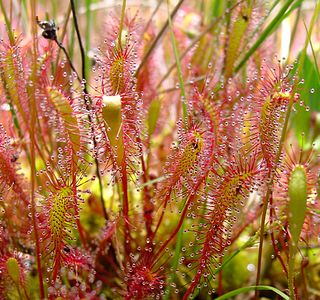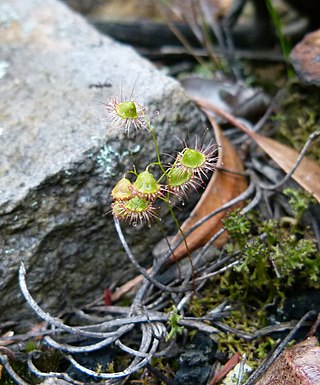
Drosera, which is commonly known as the sundews, is one of the largest genera of carnivorous plants, with at least 194 species. These members of the family Droseraceae lure, capture, and digest insects using stalked mucilaginous glands covering their leaf surfaces. The insects are used to supplement the poor mineral nutrition of the soil in which the plants grow. Various species, which vary greatly in size and form, are native to every continent except Antarctica.

Nymphaea alba, the white waterlily, European white water lily or white nenuphar, is an aquatic flowering plant in the family Nymphaeaceae. It is native to North Africa, temperate Asia, Europe and tropical Asia.

Drosera rotundifolia, the round-leaved sundew, roundleaf sundew, or common sundew, is a carnivorous species of flowering plant that grows in bogs, marshes and fens. One of the most widespread sundew species, it has a circumboreal distribution, being found in all of northern Europe, much of Siberia, large parts of northern North America, Korea and Japan but is also found as far south as California, Mississippi and Alabama in the United States of America and in New Guinea.

Drosera regia, commonly known as the king sundew, is a carnivorous plant in the sundew genus Drosera that is endemic to a single valley in South Africa. The genus name Drosera comes from the Greek word droseros, meaning "dew-covered". The specific epithet regia is derived from the Latin for "royal", a reference to the "striking appearance" of the species. Individual leaves can reach 70 cm (28 in) in length. It has many unusual relict characteristics not found in most other Drosera species, including woody rhizomes, operculate pollen, and the lack of circinate vernation in scape growth. All of these factors, combined with molecular data from phylogenetic analysis, contribute to the evidence that D. regia possesses some of the most ancient characteristics within the genus. Some of these are shared with the related Venus flytrap (Dionaea muscipula), which suggests a close evolutionary relationship.

Drosera peltata, commonly called the shield sundew or pale sundew, is a climbing or scrambling perennial tuberous species in the carnivorous plant genus Drosera. Among the tuberous sundews, D. peltata has the largest distribution, which includes eastern and western Australia, New Zealand, India, and most of Southeast Asia including the Philippines. The specific epithet is Latin for "shield shaped", a reference to the shape of the cauline leaves. It is either a single extremely variable species, or a complex of several closely related species of uncertain taxonomic boundaries. In Australia at least four forms have had or still have specific taxonomic recognition: Drosera peltata subsp. peltata, D. peltata subsp. auriculata, D. foliosa and D. gracilis.

Drosera anglica, commonly known as the English sundew or great sundew, is a carnivorous flowering plant species belonging to the sundew family Droseraceae. It is a temperate species with a circumboreal range, although it does occur as far south as Japan, southern Europe, and the island of Kauai in Hawaii, where it grows as a tropical sundew. It is thought to originate from an amphidiploid hybrid of D. rotundifolia and D. linearis, meaning that a sterile hybrid between these two species doubled its chromosomes to produce fertile progeny which stabilized into the current D. anglica.

Drosera indica is an insectivorous plant, a sundew native to tropical countries throughout the world, from Asia to Africa, but absent from the neotropics. Together with Australian endemic species D. aquatica, D. aurantiaca, D. barrettorum, D. cucullata, D. finlaysoniana, D. fragrans, D. glabriscapa, D. hartmeyerorum, D. nana, D. serpens it makes up the section Arachnopus.

Plumbago auriculata, the Cape leadwort, blue plumbago or Cape plumbago, is a species of flowering plant in the family Plumbaginaceae, native to South Africa and Mozambique.

Drosera slackii is a subtropical sundew native to the Cape Provinces of South Africa. It forms rosettes that range from to two to four inches in diameter, and produces pink flowers. It is named after the British plantsman and author Adrian Slack (1933-2018).

Drosera bicolor is an erect perennial tuberous species in the genus Drosera that is endemic to Western Australia. It produces a basal rosette of leaves similar to that of D. peltata and the stem grows to 11 cm (4 in) high. Its white flowers that have a red spot near the petal base emerge from September to October. D. bicolor grows in deep silica sand on heathland along the upper Phillips River and south-east of Lake King.

Drosera huegelii, the bold sundew, is an erect perennial tuberous species in the carnivorous plant genus Drosera that is endemic to Western Australia. It grows in sandy soils in winter-wet depressions and margins of swamps and occurs along the south-west coast of Australia. D. huegelii produces small, bell-shaped leaves along an erect stem that can be 10–50 cm (4–20 in) tall. White to cream-coloured flowers emerge from June to September.

Drosera microphylla, the golden rainbow, is an erect perennial tuberous species in the carnivorous plant genus Drosera. It is endemic to Western Australia and grows on granite outcrops or in sandy or laterite soils. D. microphylla produces small, circular, peltate carnivorous leaves along erect stems that can be 10–40 cm (4–16 in) high. It blooms from June to September, displaying its large golden sepals and smaller, variably-coloured petals. In populations near Perth, the petals are red, whereas petal colour near Albany tends to be orange. Some plants east of Esperance have white petals.
Drosera moorei is a scrambling or climbing perennial tuberous species in the carnivorous plant genus Drosera. It is endemic to Western Australia and grows near granite outcrops in sandy loam. D. moorei produces small, circular, peltate carnivorous leaves along glabrous stems that can be 12–35 cm (5–14 in) long. Inflorescences have two to ten yellow flowers and bloom from September to October.
Drosera myriantha, the star rainbow or starry sundew, is an erect perennial tuberous species in the carnivorous plant genus Drosera. It is endemic to Western Australia and is found along the coast south of Perth to Albany. It grows in swampy areas in peaty sand soils. D. myriantha produces carnivorous leaves along stems that can be 15–35 cm (6–14 in) high. White or pink flowers bloom from October to December.

Drosera radicans is an erect perennial tuberous species in the carnivorous plant genus Drosera. It is endemic to Western Australia and is only found in a relatively small area north of Geraldton. It grows in winter-wet areas in sand or sandy clay soils. D. radicans produces small carnivorous leaves along stems that can be 7–18 cm (3–7 in) high. White flowers bloom from August to September.
Drosera subtilis is an erect annual species in the carnivorous plant genus Drosera. It is native to northern Western Australia and a single site in the Northern Territory. In Western Australia, it has been collected from Beverley Springs Station, Bigge Island, and the Mitchell Plateau area all in the vicinity of the Kimberley region. In the Northern Territory, it has been found near Little Nourlangie Rock. It grows over sandstone near seepage margins in skeletal sandstone sand and black humus mixed soils. D. subtilis is anchored to the soil by a system of thin, fleshy roots and it lacks a tuber. It produces small carnivorous leaves along erect, reddish stems that can be 20 cm (8 in) high.
Drosera sulphurea, the sulphur-flowered sundew, is a scrambling perennial tuberous species in the carnivorous plant genus Drosera. It is endemic to Western Australia and is found in coastal areas in sandy loam, often among Cephalotus. D. sulphurea produces small, shield-shaped carnivorous leaves along stems that can be 40–60 cm (16–24 in) high. Yellow flowers bloom in September.

Drosera sect. Ergaleium is a section of 26 species that are erect or scrambling tuberous plants in the genus Drosera. This section represents a natural group and are taxonomically monophyletic.
Drosera zeyheri is a species in the carnivorous plant genus Drosera that is endemic to the Cape Provinces of South Africa. Some botanists treat this species to be a form of D. cistiflora. It differs from typical D. cistiflora specimens by being smaller, sometimes having cauline leaves on the short stems with white, pink, or red flowers. Botanist Fernando Rivadavia has said that he believes of all the forms and varieties in the D. cistiflora complex, D. zeyheri could possibly merit distinction at the species rank. He found it easy to distinguish it from D. cistiflora by its mostly stemless habit, though it often does present one to three leaves on the flower scape. Drosera zeyheri was first described by Terence Macleane Salter in a 1940 volume of the Journal of South African Botany.

Drosera trinervia is a species in the carnivorous plant genus Drosera that is endemic to the Cape Provinces of South Africa. It was first described by Kurt Polycarp Joachim Sprengel in his 1820 work Neue Entdeckungen im ganzen Umfang der Pflanzenkunde.















